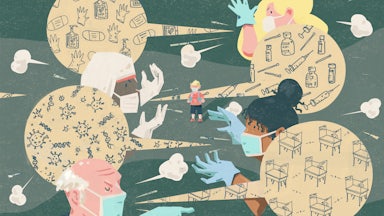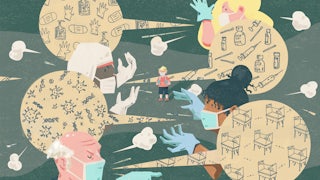Pity the newly rich, who are struggling with where to put their millions. According to a recent analysis cited by The New York Times, about 7,000 millionaires will emerge from the latest round of Silicon Valley initial public offerings, which includes companies like Airbnb, Snowflake, and Palantir, and they’re not sure how to spend it in these straitened times. While some moguls fled San Francisco for Austin, Denver, or Miami, others are plunking down for Teslas, historic homes, private at-home schooling, Bitcoin, and bizarre digital collectibles. As the Times noted, putting it mildly, “The new wealth is part of a widening gap between the tech industry and the rest of the economy.”
The last year has been good to the tech industry and, more broadly, the country’s elite, who have been cosseted by home delivery, personal servants, broad real estate portfolios, and the convenience of watching your money make money. While the rest of the economy was in tatters, with millions out of work and struggling for food and other basic necessities, millionaires and billionaires pulled down dividends from a booming stock market and found novel classes of assets in which to invest. For America’s one percent, in many respects, this was a good year. The only problem seemed to be how to spend their capital gains.
Perhaps no asset represents this strange new era of funny money—totally detached from the material concerns afflicting much of the country—more than non-fungible tokens, or NFTs. Stored on a blockchain (a distributed database of the sort that powers Bitcoin), NFTs are essentially records of ownership and provenance. They’re title deeds for increasingly useless crap. Anything—tweets, songs, text, art—can be made into one of these tokens, the only obstacle being a “gas fee” (which can be hundreds of dollars) paid by the person “minting” the token. Most NFTs don’t require consent: Digital artists—animators, painters—have found their work tokenized without their permission and then sold on collecting sites.
NFTs have stormed the art and tech worlds with the kind of viral intensity that can seemingly only accompany new technologies that promise to make a few people very rich, very quickly. In recent weeks, NFTs have been everywhere—from art to sports leagues to Twitter to porn. The tokens may be digital ephemera, but the potential rewards are huge. In February, the influencer Logan Paul sold $5 million worth of NFTs. A popular animated gif known as Nyan Cat recently sold for $580,000. Digital art collections have sold for millions. On the NBA’s Top Shot platform—one of the leaders in the NFT space—collectible video highlights are selling for tens and hundreds of thousands of dollars. On a marketplace run by a company called Cent, the first-ever tweet by Jack Dorsey, Twitter’s co-founder and CEO, is being sold for $2.5 million (to a cryptocurrency company executive, naturally).
In nearly all cases, the original media object—the cat gif or LeBron James highlight video—is still widely available online. It’s just the record of ownership that ostensibly changes. But rather than clarify digital property rights, NFTs have muddled ideas of ownership while forming a volatile, speculative market of what are essentially digital collectible trading cards. The whole arrangement is very dumb and wastes huge amounts of electricity, but don’t tell that to NFT partisans, who mostly seem to hail from the realms of finance, venture capital, and art collecting, all highly speculative industries that have been untouched by the pandemic. (Clubhouse, the platform of choice for reactionary tech elites, has been a central node in NFT discussions.)
Like Bitcoin, NFTs are essentially a multilevel marketing scheme that requires other people to buy in after you at a higher price—which is what accounts for the confluence of crypto and influencer culture and why celebrity CEOs like Jack Dorsey are strong supporters. It’s all a promotional scheme. As Everest Pipkin wrote, “In a cryptocurrency marketplace, you make money on the people who have entered the market after you.” This is easier to do with a house than with a strange digital bauble. Speaking of Bitcoin a couple years ago, Bill Gates told CNBC, “It’s kind of a pure ‘greater fool theory’ type of investment,” referring to an economic theory that boils down to whether you can sell an asset to someone else later for more than you bought it for—i.e., pass it on to another sucker.
For the ultrarich, anyone is a potential sucker. NFTs reflect a view of the world in which anything can be monetized, even if its value is entirely specious. Having exhausted traditional investments like property and stocks—as well as boutique services like concierge doctors or privileged access to the Covid-19 vaccine—the country’s idle elites are now seeking to expand their financial footprint to cover, well, anything to which they wish to lay claim.
As The New York Times reported, some digital creators have floated the idea of splitting ownership of a YouTube video into multiple NFT “shares” that they then sell on to investors. You could see where this might be headed: It’s the financialization of everything, with practically anything eligible to be tokenized, chopped up into tranches, converted into securities that intrepid day traders could buy and sell. Your life, rendered as a tradable market commodity. Or perhaps your recent tweets have failed to take off. Engagement is down; bids on Cent’s marketplace are too low. Time to short yourself. At least there might be profit in that—but maybe not for you.








